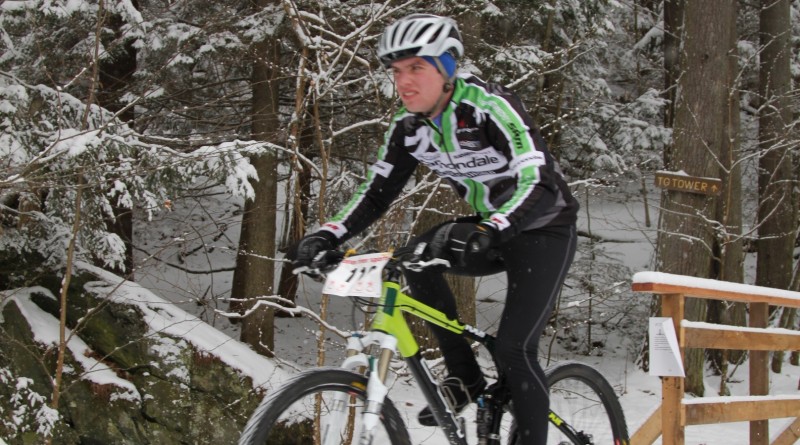Snow Biking | A Cure for the Crud Snow Blues
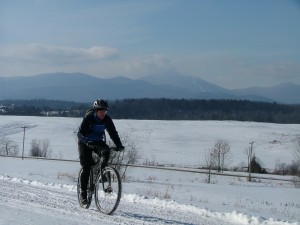 You know the kind of day you hate as a skier: the kind of day when you wake up to freezing temperatures after a thaw the previous day; the kind of day that starts with a crust. Well, here’s a way to turn that negative into a positive. Go cycling. It turns out the thaw/freeze sequence creates the best conditions for taking your mountain bike out on the trails.
You know the kind of day you hate as a skier: the kind of day when you wake up to freezing temperatures after a thaw the previous day; the kind of day that starts with a crust. Well, here’s a way to turn that negative into a positive. Go cycling. It turns out the thaw/freeze sequence creates the best conditions for taking your mountain bike out on the trails.
Brooke Scatchard of Hinesburg is part of a hardy group of Vermonters who bike the woods during winter. There are a few cross-country ski areas that allow limited biking on their snowshoe trails, but for the most part, snow biking takes place on snowmobile trails because there is an extensive network and the trails get packed down, though some cyclists head out on the Catamount Trail or other backcountry ski trails to pedal their way through winter.
“The VAST trails are like a wintertime dirt road network,” said Scatchard. “It’s not really like mountain biking. There’s no twisting and turning through the woods. It’s more like cruising along a dirt road, but it still gives you the remote feel you get from mountain biking.”
Scatchard admits the sport isn’t for everyone. There is a core group of about a dozen people who go out occasionally, and a smaller number who ride with regularity. Still, he believes the sport is growing in numbers and appeals to those looking for something to do when it’s not a powder day. Bikes designed for snow don’t have shocks, but they do have 4-inch-wide tires; slightly less than double the width of a normal mountain bike tire. They are only inflated to 5 pounds per square inch to spread out the pressure and prevent breaking through the crust. Five or six companies make bikes suitable for snow, with Surly’s Pugsley being the most popular. Scatchard has also experimented with replacing the front wheel of his bike with a ski attachment, which improves the bike’s handling. He has built these modified ski bikes for friends and likes to use them on trails with lots of turns.
Tyler Merritt of Richmond has a different approach. He rides a standard mountain bike but has studded his tires with Sheetrock screws. While an occupational hazard for summer cyclists is getting chain grease on their calves, Merritt’s problem is that he occasionally shreds his cycling tights on the screws. Since he’s a passionate skier, Merritt is unlikely to go cycling when the snow is good, but he thinks a regular mountain bike is a good alternative workout on packed-down snow. “The best time to bike is when it rains and then freezes,” he said, “so the snow is really solid.”
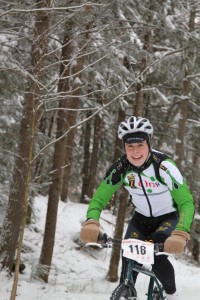 The hardest part of the sport, according to Scatchard, is keeping your hands, feet, and face warm. He favors snowshoe hiking boots for really cold days, using a flat pedal. Merritt prefers a combination of toe warmers, winter boots, and neoprene booties. For his hands, Scatchard likes bike pogies, which are big over-mitts that fit over the handle bars. Merritt likes electric heated gloves that have three levels, so he can adjust them for the different internal heat output of uphill and downhill riding. Scatchard wears clear safety glasses to protect his eyes, a thin neck warmer, and a hat under his helmet. Merritt also stressed the importance of face and eye coverage, but added that snow cyclists aren’t going as fast as their summer counterparts, so there is less chance of frostbite during descents.
The hardest part of the sport, according to Scatchard, is keeping your hands, feet, and face warm. He favors snowshoe hiking boots for really cold days, using a flat pedal. Merritt prefers a combination of toe warmers, winter boots, and neoprene booties. For his hands, Scatchard likes bike pogies, which are big over-mitts that fit over the handle bars. Merritt likes electric heated gloves that have three levels, so he can adjust them for the different internal heat output of uphill and downhill riding. Scatchard wears clear safety glasses to protect his eyes, a thin neck warmer, and a hat under his helmet. Merritt also stressed the importance of face and eye coverage, but added that snow cyclists aren’t going as fast as their summer counterparts, so there is less chance of frostbite during descents.
Scatchard started riding in winter as a way to keep his legs in shape for mountain bike racing. Although cross-country skiing was good cross-training, it wasn’t quite the same. “I guess there’s something about being on a bike in the woods that’s hard to replace,” he said. “It’s a fun way to get around, and we’re in Vermont, and it snows five months of the year, so you might as well get out there.”
Merritt agreed. “It’s a great way to get aerobic exercise,” he said. “It’s a great alternative when our other winter activities get shut down.”
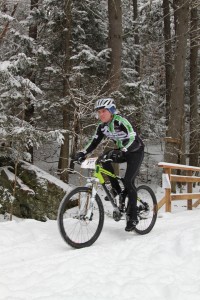 Kickin’ It Up a Notch
Kickin’ It Up a Notch
As interest in winter mountain biking grows, so has interested in winter mountain bike racing. Onion River Sports will host its third Frozen Onion Winter Mountain Biking Race on Sunday, Jan. 8 at 10 a.m. in Montpelier’s Hubbard Park.
Carrie Baker Stahler, marketing and events director for Onion River, said they’ve noticed that people were coming into the shop to get studded tires. Onion River’s general manager Kip Roberts saw that interest and suggested a winter mountain bike race, and with permission from the City of Montpelier, the race was born.
“It’s been great to be able to use those trails that are close by,” Baker Stahler said. “They freeze really well in the winter.”
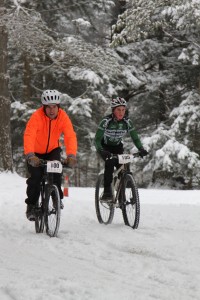 Cyclists compete in laps at the park in what can be a pretty comical race (there are some dramatic wipe-outs) and the participants range in their intensity levels, from top racers to those competing in sport coats (seriously).
Cyclists compete in laps at the park in what can be a pretty comical race (there are some dramatic wipe-outs) and the participants range in their intensity levels, from top racers to those competing in sport coats (seriously).
Last year’s race drew 28 participants, who rode through about a foot of fresh powder that had fallen the night before. Ready to try it? Check www.onionriver.com for more details.
—Vermont Sports Staff

